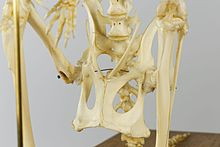
Back Os epipúbic Catalan Epipubická kost Czech Beutelknochen German Hueso epipúbico Spanish Os épipubis French Ossa epipubiche Italian Сумчатые кости Russian


Epipubic bones are a pair of bones projecting forward from the pelvic bones of modern marsupials, monotremes and fossil mammals like multituberculates, and even basal eutherians (the ancestors of placental mammals, who lack them).[1] They first occur in non-mammalian cynodonts such as tritylodontids, suggesting that they are a synapomorphy between them and Mammaliformes.
They were first described as early as 1698, but to date, their function(s) remain unresolved.[2] Epipubic bones are often called marsupial bones because they support the mother's pouch in modern marsupials ("marsupium" is Latin for "pouch").[3]
- ^ Novacek, M.J.; Rougier, G.W.; Wible, J.R.; McKenna, M.C.; Dashzeveg, D.; Horovitz, I. (1997). "Epipubic bones in eutherian mammals from the late Cretaceous of Mongolia". Nature. 389 (6650): 440–1. Bibcode:1997Natur.389..483N. doi:10.1038/39020. PMID 9333234. S2CID 205026882.
- ^ Cite error: The named reference
Reilly-White-2003-01-17was invoked but never defined (see the help page). - ^ Cite error: The named reference
White-1989was invoked but never defined (see the help page).
© MMXXIII Rich X Search. We shall prevail. All rights reserved. Rich X Search